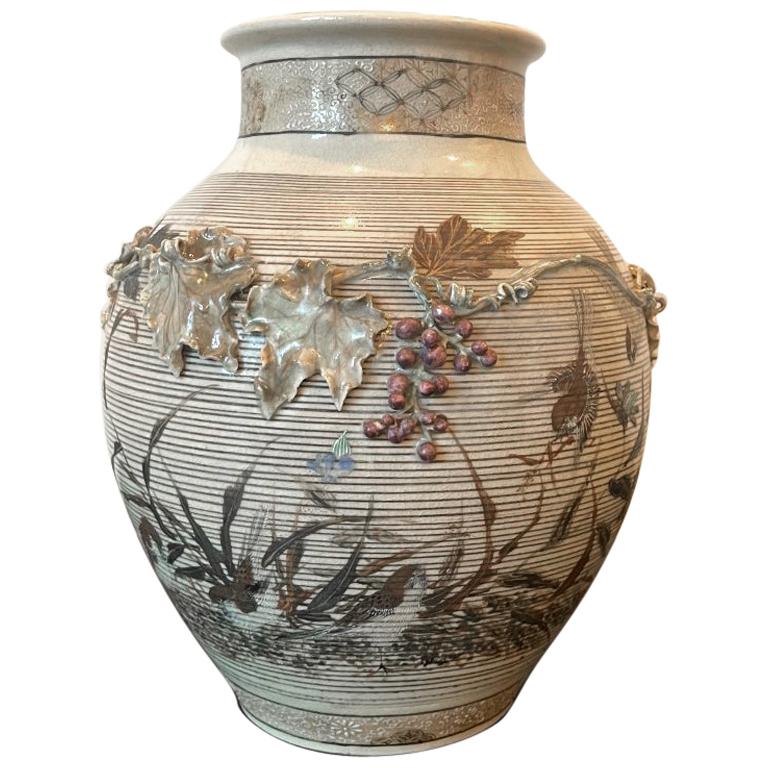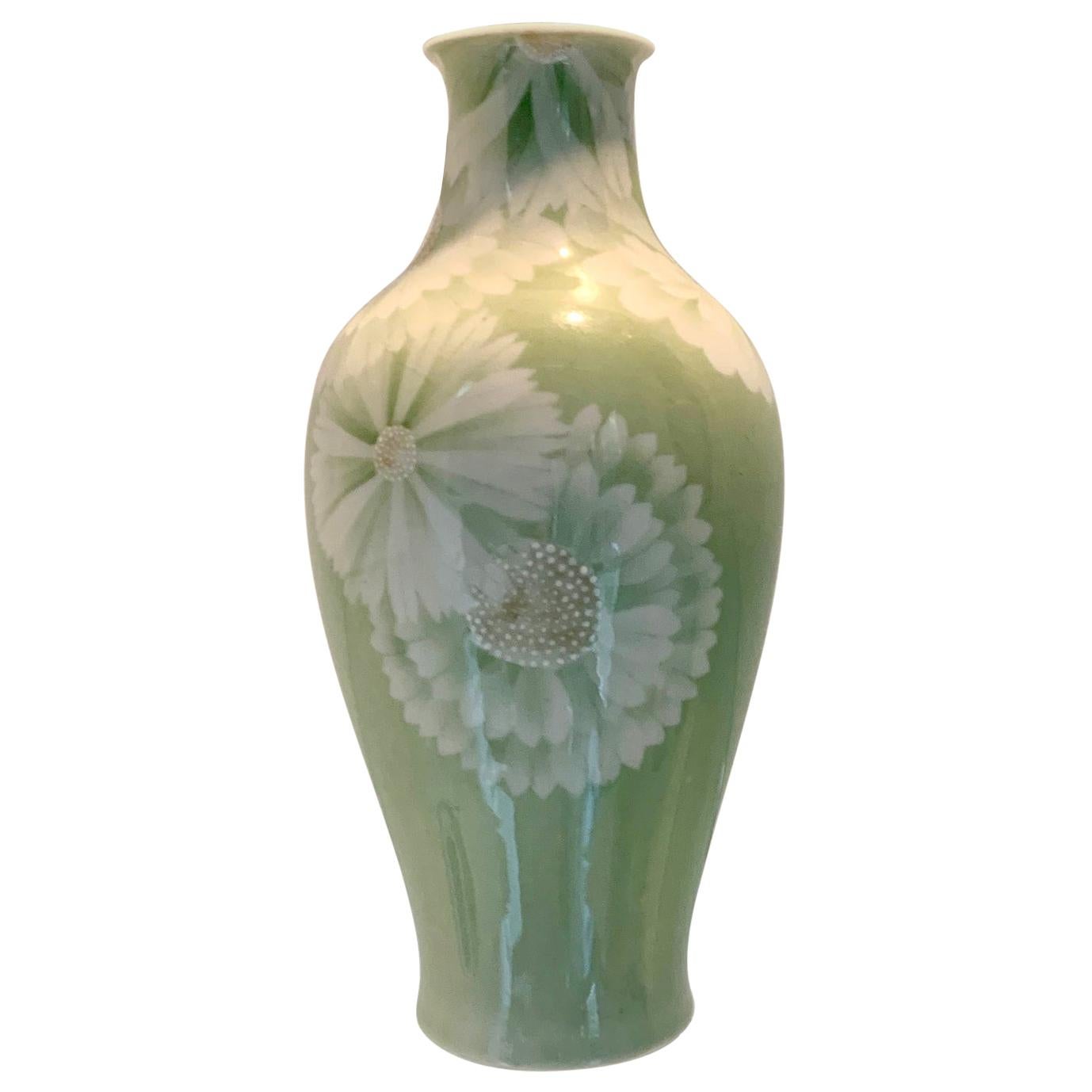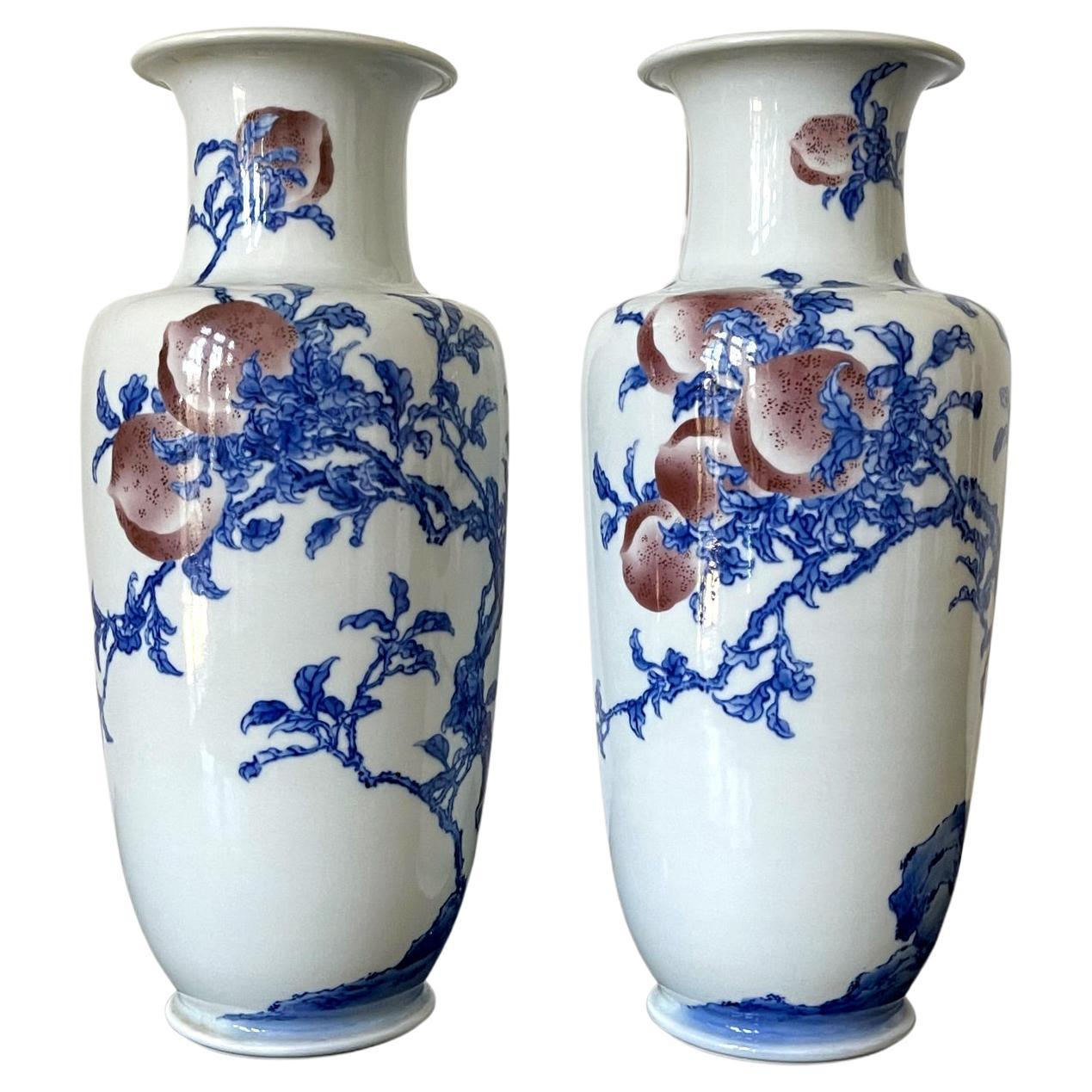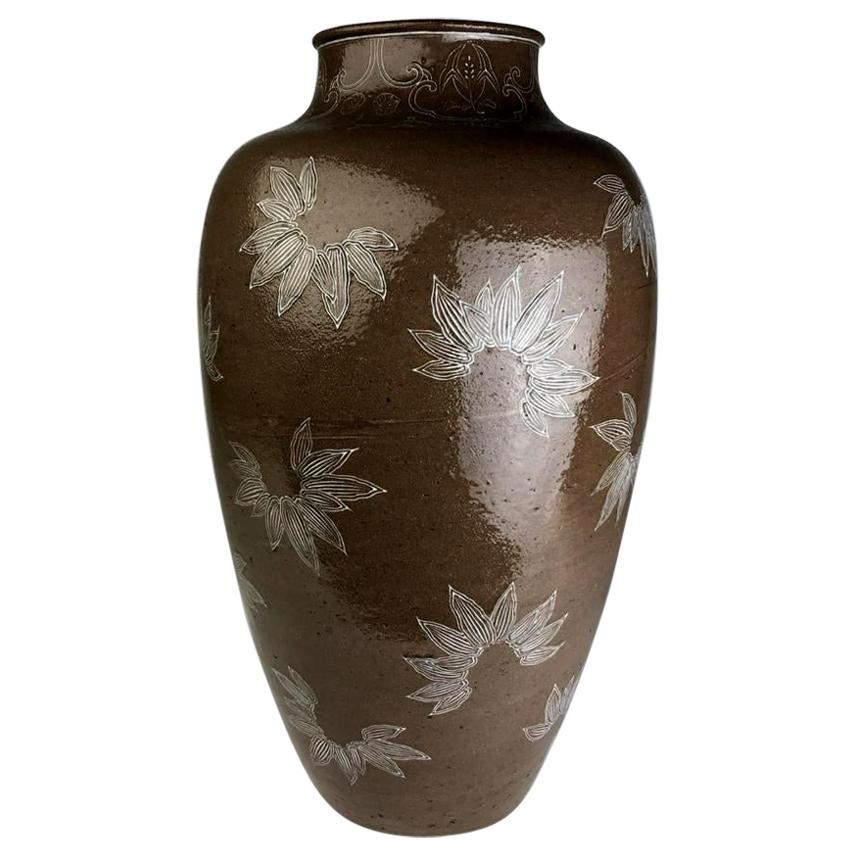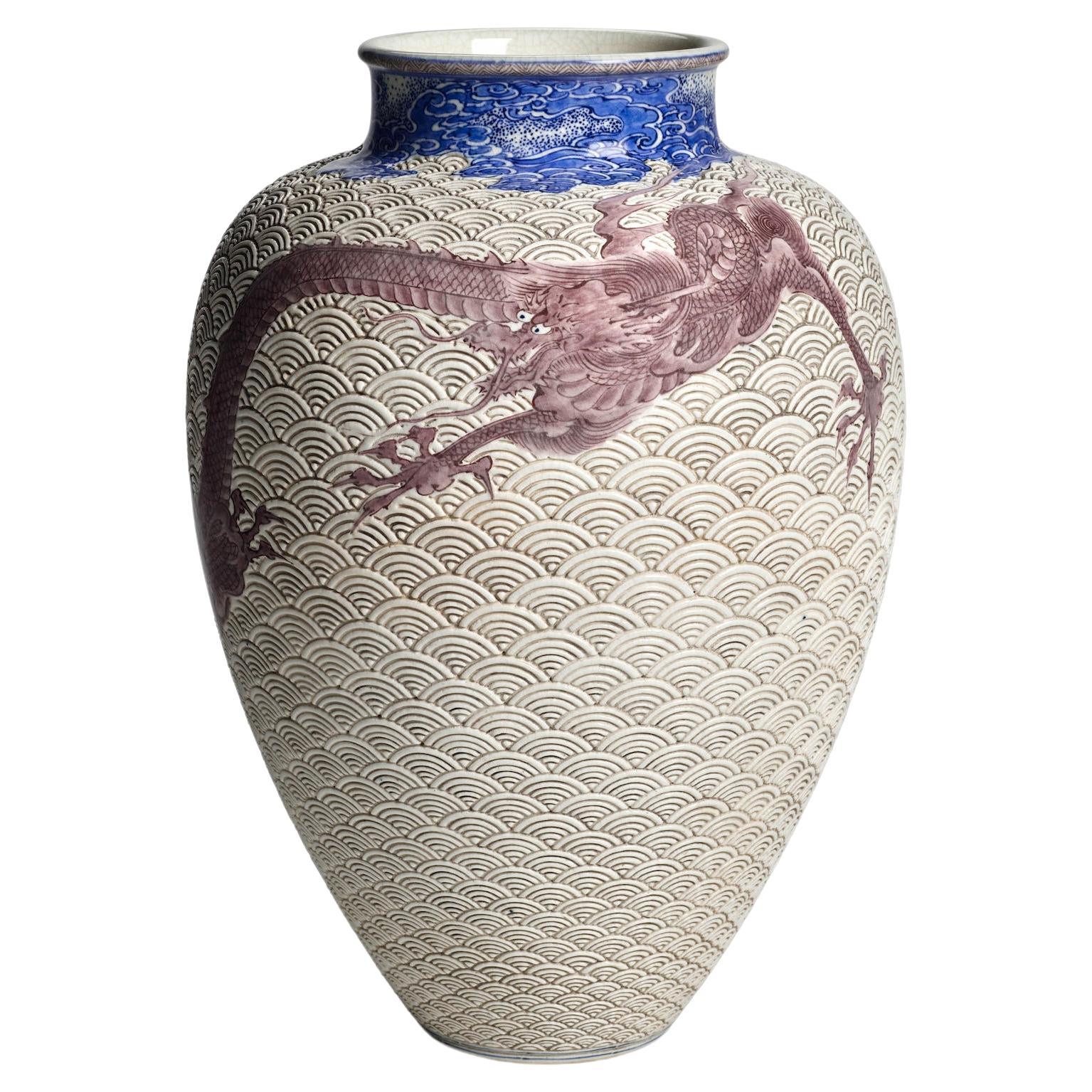Items Similar to Rare and Large Japanese Porcelain Vase Makuzu Kozan
Want more images or videos?
Request additional images or videos from the seller
1 of 11
Rare and Large Japanese Porcelain Vase Makuzu Kozan
About the Item
A striking blue and white vase from the studio of Japanese Potter Makuzu Kozan, also known as Miyagawa Kozan (1842–1916), one of the most established and collected ceramist from Meiji Period. Born as Miyagawa Toranosuke, Kozan established his pottery studio in Yokohama around 1870s and later became one of the appointed artist to the Japanese Imperial household. His work was exhibited in many international fairs that the Meiji government participated at the turn of the century and won many grand prizes.
With an impressively large size, this vase was likely made and reserved as a presentation piece for one of the many expositions the studio participated in the early 20th century. It was decorated with underglaze cobalt blue using the novel technique developed by Kozan called Fuki-e (the blow painting), in order to achieve the striking dimensional literary landscape known as "Mountain and Water". Being one of the most creative ceramists, Kozan started experimenting with new chemical colors from the West in the format of his porcelain glaze around 1880s. New colors allowed him to create underglaze designs that appeared bright, smooth and glossy. He even invented his own receipt of cobalt blue to achieve a much brighter yet softer shade, as evident on this vase. To create landscape that is realistic and dimensional, more common in the western paintings, he was inspired by the native Japanese ink painting technique developed around 1900 by Yokoyama Taikan (1868-1958) and Hishidan Shunso (1874-1911) called Morotai (Hazy style), and used cobalt blue on the porcelain like ink on paper. The fuki-e technique was demanding and uniquely featured in the works of Kozan studio.
The vase is decorated in a full circle of the continuous landscape that features mountainous peaks rising out of the ocean. Dense pine trees cover the valley and recess far into the mist. The design strikes the viewer with tremendous dimensional sense and poetic ambience. Also the tip of the mountain unconventionally climbs the shoulder instead of being confined to the body, another characteristic of the Kozan's work. It was signed underneath in an artist's archaic style seal, which the researcher dated it to Meiji 43rd year (1910). Works with these types of archaic seals were believed made mostly for oversea exhibition in International Expose during 1900-1920s. One of the best examples of Kozan's studio work.
For similar blue and white vases by Makuzu Kozan,
see Figure 2 of "Bridging East and West, Japanese Ceramics from the Kozan Studio" Walters Art Gallery. Emerson-Dell P.30.
two examples on page 182-183 of 'Miyagawa Kozan, 100 Years After Death" (Japanese version).
Figure 300 and 346 in Khalili collection "Splendors of Imperial Japan Arts of the Meiji Period from the Khalili Collection" P. 297 and 335.
- Creator:Makuzu Kozan (Artist)
- Dimensions:Height: 23.75 in (60.33 cm)Diameter: 12 in (30.48 cm)
- Style:Japonisme (Of the Period)
- Materials and Techniques:
- Place of Origin:
- Period:
- Date of Manufacture:1910s
- Condition:Wear consistent with age and use. Very fine antique condition with minimal contact wear on the base.
- Seller Location:Atlanta, GA
- Reference Number:1stDibs: LU945018518752
About the Seller
5.0
Platinum Seller
These expertly vetted sellers are 1stDibs' most experienced sellers and are rated highest by our customers.
Established in 2006
1stDibs seller since 2010
479 sales on 1stDibs
Typical response time: <1 hour
- ShippingRetrieving quote...Ships From: Atlanta, GA
- Return PolicyA return for this item may be initiated within 2 days of delivery.
More From This SellerView All
- Japanese Porcelain Vase Makuzu Kozan Meiji PeriodBy Makuzu KozanLocated in Atlanta, GAA striking blue and white vase from the studio of Japanese Potter Makuzu Kozan, also known as Miyagawa Kozan (1842–1916), one of the most established and collected ceramist from Meiji Period. Born as Miyagawa Toranosuke, Kozan established his pottery studio in Yokohama circa 1870s and later became one of the appointed artists to the Japanese Imperial household. His work was exhibited in many international fairs that the Meiji government participated at the turn of the century and won many grand prizes. Of a relatively large size, this vase is decorated with underglaze cobalt blue using the novel technique developed by Kozan called Fuki-e (the blow painting). As a result, the bamboos appear took on a three-dimensional quality as if appearing in a mist. Known as one of the most creative ceramists, circa 1887, Kozan started experimenting with new chemical colors from the West in the format of his porcelain glaze. New colors allowed him to create underglaze design that appeared bright, smooth and glossy. He even invented his own receipt of cobalt blue to achieve a much brighter yet softer shade, as evident on this vase. To create landscape that is realistic and dimensional, more common in the western paintings, he was inspired by the native Japanese ink painting technique developed around 1900 by Yokoyama Taikan...Category
Antique Early 1900s Japanese Japonisme Ceramics
MaterialsCeramic
- Japanese Porcelain Vase with Relief Surface Makuzu KozanBy Makuzu KozanLocated in Atlanta, GAA rare porcelain vase by Makuzu Kozan (1842-1916) circa 1870-81 (late Meiji period). The vase is dated to the earlier work from Kozan's studio during his early period (Takauki-ware p...Category
Antique Late 19th Century Japanese Japonisme Ceramics
MaterialsCeramic
- Japanese Porcelain Vase Meiji Period Makuzu KozanBy Makuzu KozanLocated in Atlanta, GAA finely decorated and glazed Japanese porcelain vase by Makuzu Kozan (1842-1916) circa 1900s Meiji Period. The vase is of a classic bottle form with baluster body and short neck. It was decorated with underglaze white magnolia blossom on a pleasant celadon background. The stamens of the flower were artistically rendered in a low relief, giving the design a realistic appeal with the dimension. Miyagawa Kozan...Category
Early 20th Century Japanese Meiji Ceramics
MaterialsPorcelain
- Pair of Rare Porcelain Commemorative Vases by Makuzu Kozan Meiji PeriodBy Makuzu KozanLocated in Atlanta, GAA pair of porcelain vases in classic form, decorated with underglaze blue and copper red painting by Imperial potter Makuzu Kozan. Also known as Miyagawa Kozan (1842–1916), Makuzu was one of the most established and collected ceramist known to the west from Meiji Period. The vases are in a classic Chinese form called "Bang Chu Ping" (grain-mallet vase...Category
Vintage 1910s Japanese Japonisme Ceramics
MaterialsCeramic
- Rare Large Vase with White Slip Inlay Makuzu Kozan Meiji PeriodBy Makuzu KozanLocated in Atlanta, GAA impressively large and unusual stoneware vase in an urn shape from the studio of Japanese Potter Makuzu Kozan, also known as Miyagawa Kozan (1842–1916), one of the most established and collected ceramist from Meiji Period. Born as Miyagawa Toranosuke, Kozan established his pottery studio in Yokohama circa 1870s and later became one of the appointed artist to the Japanese Imperial household. His work was exhibited in many international fairs that the Meiji government participated at the turn of the century and won many grand prizes. This vase is dated to the end of Makuzu's life circa 1910-1916 based on similar work created around that time. After achieving domestic and international fame, Makuzu retired and handed the business to his son Hanzan in 1912. He dedicated his time to other selected projects that were more in tune with Japanese sensibility than export aesthetic. He made a group of stoneware pottery pieces inspired by Edo master like Ninsei and Kenzan as well as his own poetic creation. This piece is attributed to that period. Standing of an impressive size, this vase is more like an urn, made with stoneware instead of porcelain. It was coated with a brown iron glaze with a slight translucent quality. Underglaze whit slips were used to draw low relief decoration of bamboo leaves that sparsely scatter on the surface. Slightly more elaborate scrolling vines and autumn flowers circles under the mouth rim. Same white slip inlay was used to sign the vase under the base. The whole effect of the piece is unusual. With its dark glaze in contrast with the sparse white decoration that is more abstract and geometric than realistic, it appears almost modern with an Art Deco flavor. For stoneware urn and vase in the similar genre by Makuzu Kozan: see figure 113 on page 182 of "Sekai ni Aisa Reta ya Kimono" MIYAGAWA KOZAN MAKUZU...Category
Vintage 1910s Japanese Japonisme Ceramics
MaterialsCeramic
- Large Japanese Ceramic Vase by Makuzu Kozan Meiji PeriodBy Makuzu KozanLocated in Atlanta, GAA large Japanese ceramic vase by the celebrated Meiji imperial potter Makuzu Kozan (1842-1916) circa 1880-1890s. Dated to his underglaze phase post 1887 after he successfully mastered the new colors available from the west and used them to the best advantage in his work deeply rooted in Japanese aesthetics. The vase has an impressive size and was potted in the classic baluster form with an elegant proportion. The surface is decorated using a combination of techniques of low relief sculpturing...Category
Antique Late 19th Century Japanese Meiji Ceramics
MaterialsCeramic
You May Also Like
- Large Japanese Ceramic Vase by Makuzu KozanLocated in Christchurch, GBAs part of our Japanese works of art collection we are delighted to offer this tapering square form Meiji Period 1868-1912, ceramic vase from the studios of the highly coveted Imperi...Category
Antique 19th Century Japanese Ceramics
MaterialsCeramic
- Japanese Ceramic Vase by Makuzu KozanBy Makuzu Kozan IILocated in Christchurch, GBAs part of our Japanese works of art collection we are delighted to offer this charming Meiji Period 1868-1912, ceramic baluster vase from the studios of the highly coveted Imperial ...Category
Antique 19th Century Japanese Meiji Ceramics
MaterialsCeramic
- Unusual Early 20th Century Makuzu Kozan VaseBy Makuzu KozanLocated in London, GBDecorated in iron-red and green enamels with an overall design of three shish frolicking with a brocade ball, signed on the base with an impressed seal Makuzu. The storage box ti...Category
Early 20th Century Japanese Meiji Ceramics
MaterialsPorcelain
- Unusual Japanese Studio Vase by Makuzu Kozan IIBy Makuzu Kozan IILocated in Christchurch, GBAs part of our Japanese works of art collection we are delighted to offer this most unusual Late Meiji (1868-1912) early Taisho period (1912-1926 ), globular vase stemming from the h...Category
Vintage 1920s Japanese Taisho Ceramics
MaterialsEarthenware
- Large Japanese Porcelain Studio VaseLocated in Hudson, NYWith organic abstract design. Artist signature on the bottom and on original storage box: Hasegawa Isamu. This vase exhibited at the 2nd Nitten in 1970. Hasegawa Isamu was born in 1925 in Kyoto, son of famed porcelain artist Hasegawa Hakuho...Category
Vintage 1970s Japanese Ceramics
- Charming Japanese Okimono Mandarin Ducks - Makuzu Kozan IIBy Makuzu Kozan IILocated in Christchurch, GBAs part of our Japanese works of art collection we are delighted to offer this most charming late Meiji (1868-1912) Taisho period (1912-1926) , ceramic study of Mandarin ducks from ...Category
Vintage 1920s Japanese Taisho Ceramics
MaterialsCeramic
Recently Viewed
View AllMore Ways To Browse
Large Japanese Art
Large Japanese
Japaneses Ceramics
Japanese Ceramics
Japanes Rare
Japanese Rare
Japanese Porcelain
Japanes Porcelain
Rare Asian Art
Ceramics From Japan
Large Japanese Late
Japanese Inspired Furniture
Japan Soft
Japanese Porcelain Vase
Japan Porcelain Vase
Made In Japan Ceramics
Porcelain Made In Japan
Large Japanese Porcelain

